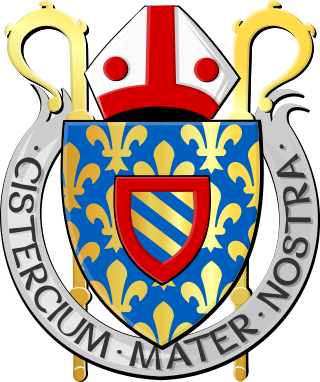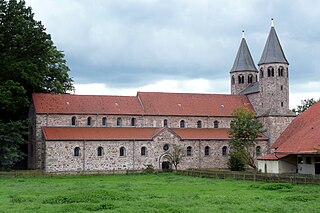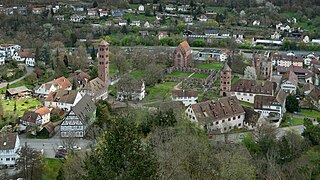Related Research Articles

The Benedictines, officially the Order of Saint Benedict, are a mainly contemplative monastic order of the Catholic Church for men and for women who follow the Rule of Saint Benedict. Initiated in 529, they are the oldest of all the religious orders in the Latin Church. The male religious are also sometimes called the Black Monks, especially in English speaking countries, after the colour of their habits, although some, like the Olivetans, wear white. They were founded by Benedict of Nursia, a 6th-century Italian monk who laid the foundations of Benedictine monasticism through the formulation of his Rule. Benedict's sister, Scholastica, possibly his twin, also became a religious from an early age, but chose to live as a hermit. They retained a close relationship until her death.

The Cistercians, officially the Order of Cistercians, are a Catholic religious order of monks and nuns that branched off from the Benedictines and follow the Rule of Saint Benedict, as well as the contributions of the highly influential Bernard of Clairvaux, known as the Latin Rule. They are also known as Bernardines, after Saint Bernard, or as White Monks, in reference to the colour of their cowl, as opposed to the black cowl worn by Benedictines.

Melk Abbey is a Benedictine abbey above the town of Melk, Lower Austria, on a rocky outcrop overlooking the Danube river, adjoining the Wachau valley. The abbey contains the tomb of Saint Coloman of Stockerau and the remains of several members of the House of Babenberg, Austria's first ruling dynasty.

The Schottenstift, formally called Benediktinerabtei unserer Lieben Frau zu den Schotten, is a Catholic monastery founded in Vienna in 1155 when Henry II of Austria brought Irish monks to Vienna. The monks did not come directly from Ireland, but came instead from Scots Monastery in Regensburg, Germany. Since 1625, the abbey has been a member of the Austrian Congregation, now within the Benedictine Confederation.
The Canons Regular of St. Augustine are Catholic priests who live in community under a rule and are generally organised into religious orders, differing from both secular canons and other forms of religious life, such as clerics regular, designated by a partly similar terminology. As religious communities, they have laybrothers as part of the community.

The Schottenkirche is a parish church in Vienna attached to the Schottenstift, founded by Irish Benedictine monks in the 12th century. In 1418, the Duke Albert V of Austria transferred it to the German-speaking Benedictine monks from the Melk Abbey during the Melker Reform initiated after the Council of Constance. The church was elevated to the rank of Basilica Minor in 1958.
The Cluniac Reforms were a series of changes within medieval monasticism in the Western Church focused on restoring the traditional monastic life, encouraging art, and caring for the poor. The movement began within the Benedictine order at Cluny Abbey, founded in 910 by William I, Duke of Aquitaine (875–918). The reforms were largely carried out by Saint Odo and spread throughout France, into England, and through much of Italy, northern Portugal and Spain.

Bursfelde Abbey is a former Benedictine monastery located in Bursfelde, a hamlet which for administrative purposes is included in the municipality of nearby Hannoversch Münden in Lower Saxony, Germany. Today the abbey church and its estate cover a site of approximately 300 hectares which is administered by the Klosterkammer Hannover, a body that operates under the auspices of the Lower Saxony Ministry for Arts and the Sciences to look after reassigned or disused ecclesiastical buildings and other heritage properties in the region. The legal owner of the Bursfelde Monastery Complex is the Evangelical-Lutheran Church of Hanover.

Hirsau Abbey, formerly known as Hirschau Abbey, was once one of the most important Benedictine abbeys of Germany. It is located in the Hirsau borough of Calw on the northern slopes of the Black Forest mountain range, in the present-day state of Baden-Württemberg. In the 11th and 12th century, the monastery was a centre of the Cluniac Reforms, implemented as "Hirsau Reforms" in the German lands by William of Hirsau. The complex was devastated during the War of the Palatine Succession in 1692 and not rebuilt. The ruins served as a quarry for a period of time.

Tegernsee Abbey is a former Benedictine monastery in the town and district of Tegernsee in Bavaria. Both the abbey and the town that grew up around it are named after the Tegernsee, the lake on the shores of which they are located. The name is from the Old High German tegarin seo, meaning great lake.

Muri Abbey was a Benedictine monastery dedicated to Saint Martin of Tours. It flourished for over eight centuries at Muri, in the Canton of Aargau, near Zürich, Switzerland. While the monastery is currently established as Muri-Gries in South Tyrol, the former abbey is now a museum and heritage site of national significance.

Kremsmünster Abbey is a Benedictine monastery located in Kremsmünster, Upper Austria.

The Bursfelde Congregation, also called Bursfelde Union, was a union of predominantly west and central German Benedictine monasteries, of both men and women, working for the reform of Benedictine practice. Named after Bursfelde Abbey, it included over 100 monasteries in middle Europe.
St. Stephen's Abbey, Augsburg is a Benedictine monastery, formerly a house of Augustinian canonesses, in Augsburg in Bavaria, Germany.

St Peter's Abbey, or St Peter's Archabbey, is a Benedictine monastery and former cathedral in the Austrian city of Salzburg. It is considered one of the oldest monasteries in the German-speaking area, and in fact the oldest with a continuous history since its foundation in 696.
The Austrian Congregation is a congregation of Benedictine monasteries situated in Austria, within the Benedictine Confederation.
Münsterschwarzach Abbey, is a monastery for Benedictine monks in Germany. It is located in Schwarzach am Main, a small market town at the confluence of the rivers Schwarzach and Main in north-eastern Bavaria.

Stiftsgymnasium Melk is a Roman Catholic Benedictine-run gymnasium located in Melk, Austria. The gymnasium is located within and run by the well-known monastery Melk Abbey. Founded in the 12th century as a monastic school, it is also the oldest continuously operating school in present-day Austria.

The Wachau is an Austrian valley with a picturesque landscape formed by the Danube river. It is one of the most prominent tourist destinations of Lower Austria, located midway between the towns of Melk and Krems that also attracts "connoisseurs and epicureans" for its high-quality wines. It is 36 kilometres (22 mi) in length and was already settled in prehistoric times. A well-known place and tourist attraction is Dürnstein, where King Richard I of England was held captive by Leopold V, Duke of Austria. The architectural elegance of its ancient monasteries, castles and ruins combined with the urban architecture of its towns and villages, and the cultivation of vines as an important agricultural produce are the dominant features of the valley.
References
- 1 2 3 Tom Gaens, "Water with the Wine: Henry of Coesfeld as a Defining Theologian of Melker Reform Thought", in M. Niederkorn-Bruck and G. Glassner (eds.), 600 Jahre Melker Reform (1418–2018), Thesaurus Mellicensis 6 (Melk, 2022), pp. 126–144.
- 1 2 Melker Reform in Austria-Forum (in German) (at AEIOU). Published online 25 March 2016, retrieved 1 January 2025.
- ↑ James D. Mixson, Poverty's Proprietors: Ownership and Mortal Sin at the Origins of the Observant Movement (Brill, 2009), pp. 139ff.